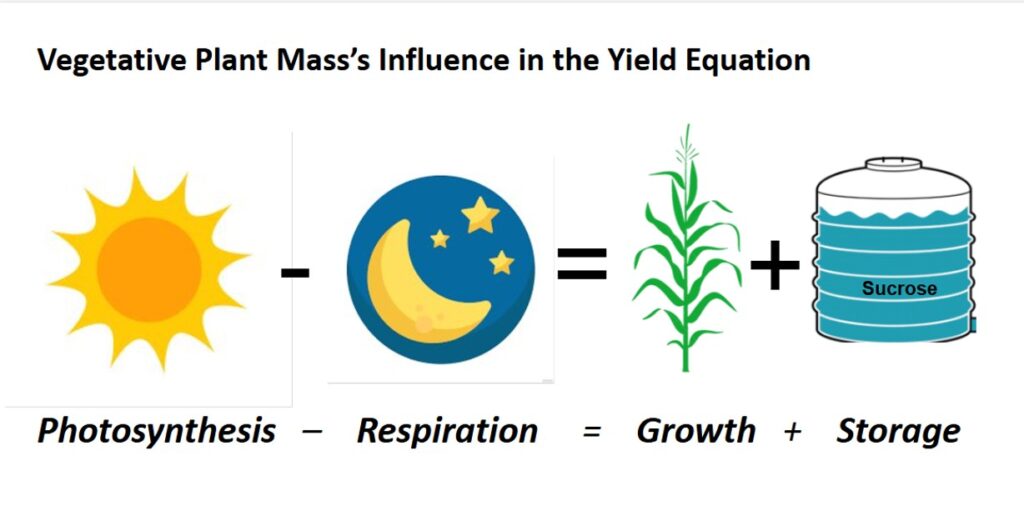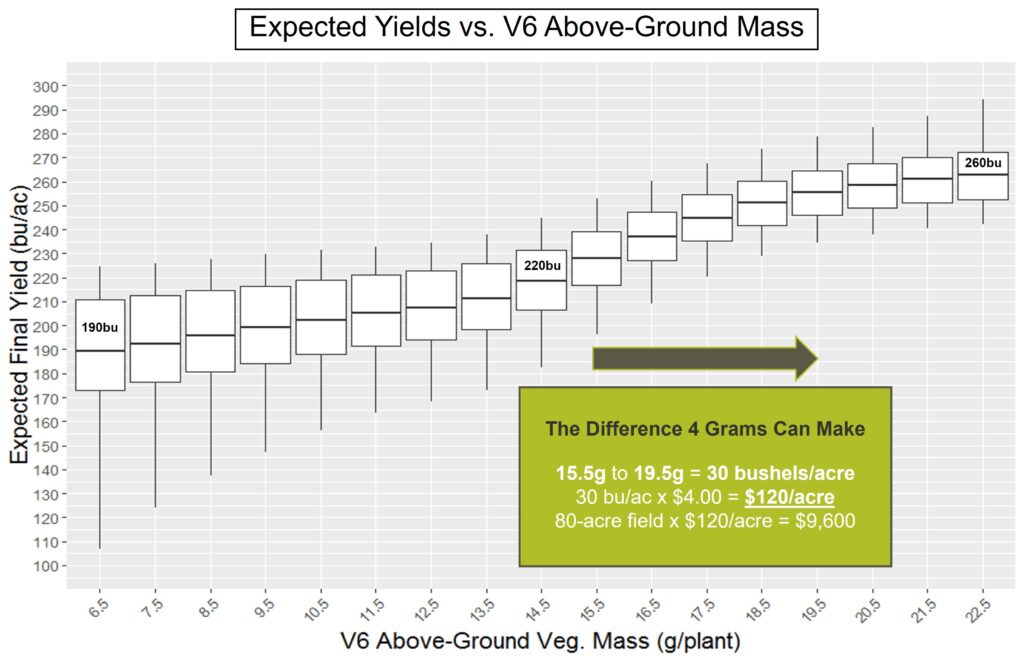The difference between average and outstanding yield potential in corn production often comes down to one thing: how efficiently the plant produces and stores sucrose. Advanced Agrilytics focuses on maximizing early season growth and sucrose production because the decisions you make now will directly impact your harvest outcome.
Why Is Efficient Sucrose Production So Important?
Sucrose is the energy currency of the corn plant. It’s the product of photosynthesis that powers vegetative growth and ultimately grain fill. When the plant’s immediate growth needs are met, any excess energy is stored as sucrose, typically in the lower internodes of the stalk. This reserve functions like a fuel tank the plant draws from during periods of stress, whether that stress is heat, drought, nutrient deficiency, or disease.
How Vegetative Plant Mass and Photosynthesis Affect Sucrose
To understand sucrose accumulation, we first need to understand The Growth Equation: Photosynthesis – Respiration = Growth + Sucrose Storage.

This is the corn growth equation. The energy that builds up in the corn plant during the day (via photosynthesis) minus the process of respiration that happens overnight equals plant growth and sucrose storage. Sucrose is a form of sugar that the corn plant stores and uses as energy to help protect itself during periods of stress.
When growing conditions are good, the plant produces enough energy to meet the energy requirements for maintenance respiration and growth, and any excess is set aside in storage. Plants with poor growing conditions or incomplete canopy closure will produce less energy, which will limit growth or maybe even draw sucrose out of storage to meet the energy demands of that day.
This means the plant must capture enough sunlight (photosynthesis) and minimize energy loss (respiration). What’s left goes toward growing the plant and storing sucrose. That’s why vegetative plant mass (VPM) matters so much: a larger plant has more leaf area (or leaf area index), meaning it is better equipped to capture sunlight, producing more energy and thus more sucrose. In addition, these larger plants will close the canopy more quickly, lowering canopy temperatures and reducing respiration demands.

This chart shows the difference that just 4 grams of above-ground plant mass can make regarding yield. The difference in yield between plants with 15.5 g of mass at the V6 growth stage, versus plants with 19.5 g of mass was 30 bushels/acre. At $4/bushel, that’s $120/acre. For an 80-acre field, that’s $9,600 in lost yield for the underweight plants.
The consequences of delayed plant development in the early vegetative growth stages are real. While delayed vegetative growth by the V6–V8 stages can put plants at a disadvantage, there are still targeted strategies available to help them catch up, boosting photosynthetic capacity and sucrose accumulation before the R1 growth stage. Acting now can be the difference between a struggling plant, and one positioned to withstand stress and complete grain fill successfully.
Why Timing Matters: The Critical Mid-Vegetative Window
As we move through the rapid vegetative growth phase, it’s time to evaluate crop conditions and determine whether your corn has the biomass, health, and nutrient access it needs to build sucrose reserves before the R1 stage.
Five Key Factors That Influence Sucrose Production and Storage
- Nitrogen Availability
Nitrogen is one of the most critical nutrients for early-season corn development. If nitrogen is not readily available during the early vegetative stages, plants may struggle to establish sufficient biomass, resulting in delayed canopy closure and reduced photosynthetic capacity. Excess rainfall early in the season can lead to nitrogen loss through leaching or denitrification, particularly in low-lying or poorly drained areas. Fields that did not receive a proactive nitrogen management plan may need reactive strategies mid-season.
- pH, Phosphorus, and Potassium Levels
Balanced soil fertility is essential for efficient sucrose production. Soil pH directly affects nutrient availability, and imbalances—such as low pH or excessive calcium—can tie up phosphorus, making it inaccessible to plants. Phosphorus is essential for energy transfer and root development, while potassium regulates water use and helps with stress resistance. Variability within fields often means some sub-acre zones lack sufficient moisture which reduces nutrient uptake, which, in turn, can reduce overall plant growth and sucrose storage potential.
- Photosynthetic Efficiency
Photosynthesis drives energy production in the plant, which supports both growth and sucrose storage. Limitations such as persistent cloud cover, physical damage to leaf tissue, or reduced leaf area due to early-season stress can negatively impact the plant’s ability to photosynthesize effectively. Maximizing light interception and leaf health during the vegetative period is key to ensuring that plants produce and store the sugars needed for later reproductive success.
- Heat and Moisture Stress
Young corn plants are particularly sensitive to temperature and water availability. High temperatures, especially when combined with inadequate soil moisture, can lead to stress responses such as stomatal closure and leaf rolling, which reduce photosynthesis and limit sucrose production. Conversely, excessive moisture can lead to oxygen deprivation in the root zone and increase the likelihood of nutrient loss.
- Disease Pressure
Foliar diseases such as gray leaf spot, tar spot, or rusts reduce green tissue area, disrupting photosynthesis and increasing plant respiration. When disease pressures remove photosynthetically active leaf area, the plant must work harder to meet its energy demands, and stored sucrose may be used prematurely. Managing disease risk through regular scouting and early detection helps protect sucrose storage by preserving the integrity of the plant’s photosynthetic machinery.
How Advanced Agrilytics Can Help
Our approach to agronomy is grounded in spatially precise, data-informed strategy. Through years of internal research and trials through our research and development division, called Ag Ingenuity Partners (AIP), we know exactly which environments respond best to specific crop inputs. Only our precision agronomists have access to this data, and they use it to create customized strategies for each customer’s unique conditions.
What You Can Do Next
If you’re concerned about nutrient access, canopy development, or overall plant vigor—especially in acres that were planted late, have a history of poor performance, or face other agronomic challenges, it’s time to act.
Contact your local Advanced Agrilytics agronomist or reach out to us online. We’ll assess your current conditions and guide you to the products and practices that can protect yield potential by enhancing photosynthesis and sucrose storage, before stress arrives.
© 2025 Advanced Agrilytics Holdings, LLC. All rights reserved. Advanced Agrilytics and design are trademarks of Advanced Agrilytics Holdings, LLC.